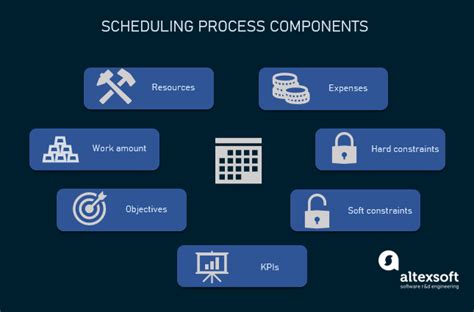Schedule Optimization

In today's fast-paced world, effective time management and efficient scheduling have become essential skills for individuals and businesses alike. The ability to optimize schedules can greatly impact productivity, work-life balance, and overall success. With the increasing demand for better time utilization, various tools and techniques have emerged to help streamline daily routines and enhance productivity. This article delves into the world of schedule optimization, exploring the latest strategies, technologies, and best practices to help you make the most of your time.
The Importance of Schedule Optimization

Schedule optimization is not merely about filling up your calendar; it’s about strategically organizing your time to achieve maximum efficiency and effectiveness. In a world where multitasking has become the norm, learning to prioritize and allocate time appropriately is crucial. Optimizing your schedule can lead to improved focus, reduced stress, and increased productivity, allowing you to accomplish more in less time.
For businesses, schedule optimization is a critical component of operational excellence. It involves allocating resources efficiently, reducing waste, and ensuring that operations run smoothly. By optimizing schedules, companies can improve customer satisfaction, enhance employee morale, and boost overall profitability. Whether it's managing project timelines, optimizing shift schedules, or streamlining daily tasks, schedule optimization is a powerful tool for success.
Understanding the Principles of Schedule Optimization

At its core, schedule optimization revolves around three key principles: prioritization, flexibility, and adaptability. Prioritization involves identifying the most critical tasks and allocating time accordingly. This ensures that your focus is on the activities that have the highest impact and value. Flexibility is essential to accommodate unexpected events or changes in priorities. Being adaptable allows you to adjust your schedule as needed, ensuring that you remain responsive to changing circumstances.
To optimize your schedule effectively, you must also consider your personal preferences, work style, and the nature of your tasks. Some individuals thrive in a structured environment with a detailed plan, while others prefer a more flexible and spontaneous approach. Understanding your unique needs and adapting your schedule accordingly is crucial for success.
The Role of Time Blocking
One popular technique in schedule optimization is time blocking. This method involves dividing your day into specific blocks of time, each dedicated to a particular task or activity. By allocating dedicated time slots for different tasks, you can improve focus, reduce multitasking, and increase productivity. Time blocking also helps you prioritize tasks and ensures that you allocate sufficient time for each activity.
| Time Block | Activity |
|---|---|
| 9:00 AM - 10:30 AM | Project Planning |
| 10:30 AM - 12:00 PM | Email Management |
| 12:00 PM - 1:00 PM | Lunch Break |
| 1:00 PM - 3:00 PM | Client Meeting |
| 3:00 PM - 4:30 PM | Data Analysis |
| 4:30 PM - 5:30 PM | Review and Planning for Next Day |

In the table above, we can see an example of a time-blocking schedule for a professional. This approach ensures that each task receives dedicated attention, improving overall productivity.
Leveraging Technology for Schedule Optimization
In today’s digital age, technology plays a vital role in optimizing schedules. From calendar apps to project management software, there is a plethora of tools available to help you organize your time effectively. Here are some key technologies that can enhance your schedule optimization efforts:
Calendar Apps
Calendar apps are powerful tools for managing your schedule. They allow you to create and manage events, set reminders, and share your availability with others. Many calendar apps also offer features like event planning, travel time estimation, and task integration. By using a calendar app, you can easily visualize your schedule, make adjustments, and stay organized.
Project Management Software
Project management software is designed to help teams and individuals manage complex projects efficiently. These tools provide features like task management, collaboration, and progress tracking. By using project management software, you can break down large projects into smaller, manageable tasks, set deadlines, and assign responsibilities. This ensures that your projects stay on track and your schedule is optimized.
Task Management Apps
Task management apps are excellent for organizing and prioritizing your to-do list. These apps offer features like task categorization, due date setting, and priority ranking. Some task management apps also integrate with calendar apps, allowing you to sync your tasks with your schedule. By using a task management app, you can ensure that no task falls through the cracks and that your time is allocated effectively.
Best Practices for Schedule Optimization
While technology can greatly assist in schedule optimization, it’s important to follow best practices to ensure maximum effectiveness. Here are some key strategies to consider:
Set Clear Goals and Priorities
Before you begin optimizing your schedule, it’s crucial to set clear goals and priorities. Understand what you want to achieve and what tasks are most important to your success. By setting specific goals, you can align your schedule with your objectives and ensure that your time is spent wisely.
Create a Realistic Schedule
When creating your schedule, be realistic about the time each task requires. Overestimating or underestimating task durations can lead to an unrealistic schedule. Take into account your personal work style, potential distractions, and unexpected events. By creating a realistic schedule, you can avoid overloading yourself and ensure that your plan is achievable.
Break Tasks into Manageable Chunks
Large, complex tasks can be overwhelming and may lead to procrastination. Break down these tasks into smaller, more manageable chunks. By doing so, you can tackle each part systematically, making progress more tangible and motivation easier to sustain.
Prioritize Self-Care
Schedule optimization should not come at the expense of your well-being. Prioritize self-care activities like exercise, healthy meals, and relaxation. By taking care of yourself, you can maintain your energy levels, focus, and productivity throughout the day. Incorporate breaks and downtime into your schedule to ensure you stay refreshed and energized.
Regularly Review and Adjust
Schedule optimization is an ongoing process. Regularly review your schedule to assess its effectiveness and make adjustments as needed. Evaluate your progress, identify areas for improvement, and adapt your plan accordingly. By staying flexible and responsive, you can ensure that your schedule remains optimized and aligned with your goals.
Future Trends in Schedule Optimization

As technology continues to advance, we can expect to see innovative solutions and trends in schedule optimization. Here are some potential developments that may shape the future of schedule optimization:
Artificial Intelligence and Machine Learning
Artificial intelligence (AI) and machine learning algorithms can analyze patterns in your schedule, predict optimal task durations, and suggest efficient scheduling strategies. These technologies can learn from your behavior, adapt to your preferences, and provide personalized recommendations for schedule optimization.
Wearable Technology
Wearable devices, such as smartwatches and fitness trackers, can provide valuable insights into your daily activities and health. These devices can monitor your sleep patterns, activity levels, and stress levels, helping you make informed decisions about your schedule. By integrating wearable technology with schedule optimization tools, you can create a more holistic approach to time management.
Smart Scheduling Tools
Smart scheduling tools are emerging to automate and optimize your schedule. These tools can analyze your calendar, prioritize tasks based on importance and urgency, and suggest efficient scheduling arrangements. With smart scheduling, you can save time and effort, allowing you to focus on your work rather than the logistics of scheduling.
Integration of Health and Wellness
In the future, we can expect schedule optimization tools to integrate more closely with health and wellness apps. By combining your schedule with your health data, these tools can suggest optimal times for exercise, meditation, or other wellness activities. This integration will help you maintain a healthy balance between work and personal well-being.
Conclusion
Schedule optimization is a powerful tool for individuals and businesses seeking to enhance productivity and achieve success. By understanding the principles of prioritization, flexibility, and adaptability, you can create an optimized schedule that aligns with your goals and priorities. With the help of technology and best practices, you can streamline your daily routines and make the most of your time.
As we look to the future, the integration of advanced technologies and a focus on holistic well-being will shape the landscape of schedule optimization. By staying informed and adapting to these trends, you can continue to optimize your schedule and thrive in a fast-paced world.
How often should I review and adjust my schedule?
+It’s recommended to review your schedule on a weekly basis. This allows you to assess your progress, make adjustments as needed, and stay aligned with your goals. However, if your schedule is particularly dynamic or you encounter significant changes, more frequent reviews may be necessary.
What are some common challenges in schedule optimization?
+Common challenges include overestimating or underestimating task durations, unexpected events disrupting your schedule, and difficulty prioritizing tasks. Additionally, finding a balance between work and personal life can be a challenge, especially when optimizing your schedule.
How can I stay motivated when following an optimized schedule?
+Staying motivated requires a combination of discipline and self-awareness. Set clear goals, break tasks into manageable chunks, and celebrate your accomplishments along the way. Additionally, prioritize self-care activities to maintain your energy and enthusiasm.


